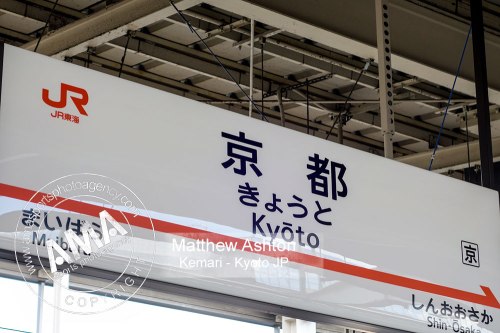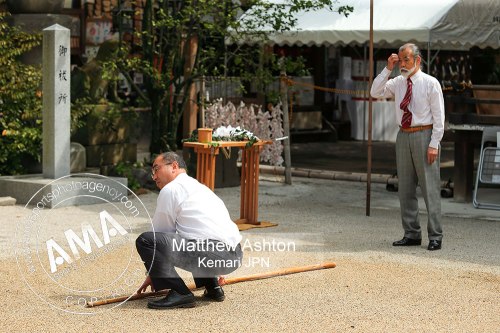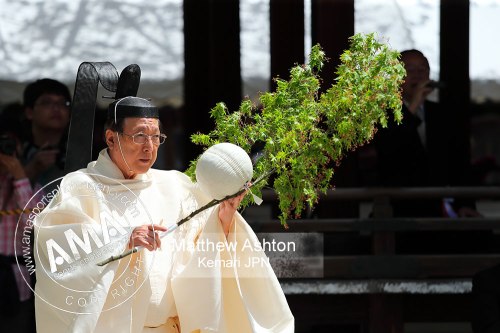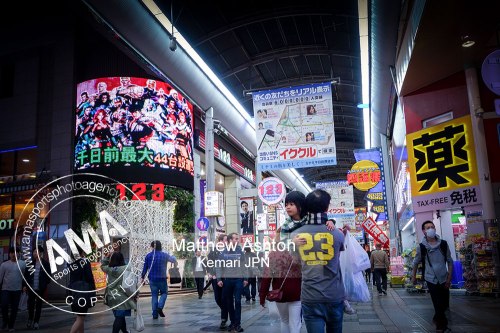I first encountered Kemari in June 2002 when I went to Kyoto during my time covering the FIFA 2002 World Cup in Japan. I never once dreamed, hoped or wished to photograph a World Cup Final, a big European game or similar, everything I have done has just kind of happened. However, after starting up AMA, having more freedom and being my own boss, I have always wanted to return to Japan and cover Kemari.

After flying to Haneda Airport in Tokyo, I got the Shinkansen Bullet Train to Osaka. Osaka is my Japanese Madrid. I famously went to Madrid 22 times before actually venturing into the city and having a look around – and now I love it!

The same goes for Osaka. Even though I went to Osaka to photograph the construction of the Nagai Stadium for the World Cup, even though I covered every game at the World Cup that was staged in Osaka, it was not until last year when I covered the J2 League Final and the FIFA Club World Cup that I actually stayed here and had the chance to look around.

Tokyo will always be in my heart, but I could certainly live in worse places than Osaka!

After staying in Osaka for a day, looking around camera shops, model railway stores, clothing shops the famous sights like the famous Osaka Castle and discovering all kinds of new things, another Shinkansen took me to the old city of Kyoto.

Normally when I go to a city to cover a football match, even when I am totally lost, it is usual to spot a fan wearing club colours going in the same direction as me which gave an assurance that I was on the correct route.

Kyoto is much like any other Japanese city in terms of having a simply wonderful transport system.

Though being the only passenger to walk down an exit to a supposedly big annual event was a bit daunting.
Thanks to Google Maps I reached the Shrine hours ahead of schedule.

A sign outside the Shrine confirming that I was in the right place.
I am renowned for turning up late, especially at Manchester City – I blame the traffic – but sometimes I am incredibly early. I have been known to get to a stadium at 7am to document the groundsmen at work for a 7.45pm kick off.

It was no surprise then when I saw the Kemari people marking out the pitch!
The Shrine wasn’t an epic Borussia Dortmund type venue. Although very nice, it was not as picturesque and grand as some of the other shrines, but this is a special shrine.
There are two former emperors of Japan buried in this shrine: Emperor Junnin and Emperor Sutoku. Emperor Junnin was born in 733.
In 2002, the Kemari I covered, was staged in a beautiful majestic shrine, however, Kemari is played every year on April 14 in Shiramine Shrine, Kyoto.
April 14th is reserved for the celebration of the Emperor Junnin and people play Kemari in order to receive blessings from the Gods of this Shrine.

The Shrine is also known as the spirit God of ball sports, and the shrine “store” is the only one in Japan which sells “fighting spirit” amulets – a small piece of jewellery thought to give protection against evil, danger, or disease.

Therefore, famous sportspersons and club members visit this shrine to buy them and carry them for luck in competitions and pictures of men and women’s Japanese National football teams are there to be seen.

In the Shrine, there were Kemari Emas – small wooden tablets carrying a picture of Kemari players hangs up amongst other Emas, in the hope that the gods will grant wishes during an exhibition of Kemari by players at Shiramine Shrine
There is also the monument of Kemari, which is said that you can get a good luck on sports by spinning the ball prior to an exhibition of Kemari by players at Shiramine Shrine

After some Shinto Priests (I think) did some blessings in the Shrine, the players came out and put on their boots.

The costumes were amazing. The looked heavy but were in fact incredibly light but tough.


The players wear Heian Period dress.


After being blessed in the Shrine, the ball called a Mari, made out of deer skin, was used in a pre-match ceremony.



Kemari is an ancient form of football – though it is not recognised by FIFA as an original for of football, due to the fact that no one scores goals or points and thus there is no winner.

No player is allowed to use their hands. When the players kick the ball, they call to each other in a way of encouragement. There are no winners or losers, and no time limits.

Therefore, it is important for the players to kick the ball to each other as accurately as possible.

Staged on a square court, known as a Kakari, in essence, it is a kick about!

However, like all kick abouts, when young boys kick the ball over the fence and break the neighbours greenhouse or get it stuck on the garage roof, the Kemari people had a large stick to remove the ball when it got stuck in a tree!
And so one of the things on my bucket list had been ticked off. I chatted afterwards to some of the players who told me that they play each month in a variety of Shrines, giving me tips on the most picturesque, but made it quite clear that today was the special day and that I had come on the correct day to document the Kemari.
And in true Japanese fashion, like Mr Benn going through the magic door in his changing room and discovering another world, upon leaving the Shrine I was back in the Japan of today.

After a trip on a very quiet Shinkansen, I was back in Osaka exploring more shopping streets, trying to put off the inevitable of having to do a concise edit of my 3,000+ pictures that I had taken!

© Matthew Ashton / AMA 2016


